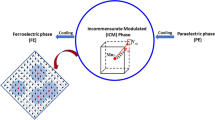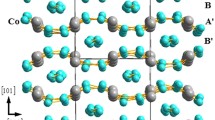Abstract
The paraelectric to antiferroelectric phase transition in titanite at ∼500 K involves a displacement of the titanium atom from the center of the [TiO6] octahedron in the paraelectric phase (A2/a) to an off-center position in the antiferroelectric (P2 1/a) phase. We have carried out a detailed single crystal high temperature x-ray diffraction study of the phase transition including structure refinements at 294, 350, 400, 430, 440, 450, 500, 600, and 700 K. The unit cell dimensions show a pronounced hysteresis effect in the 450–500 K range on heating and cooling during the first cycle along with a reduction of the transition temperature, T c from 495 ± 5 K on heating to 445 ± 5 K on cooling. The hysteresis effect disappears on further heating and the superstructure reflections show residual intensities above T c (445 K). An order parameter treatment of the phase transition is presented in terms of Landau theory and induced representation theory. The Ti-displacements parallel and antiparallel to a are taken as the primary order parameter η, which transforms as the Y +2 representation. A coupling of Y +2 with T +1 results in the linear-quadratic coupling of the spontaneous strain components, ɛ ij with η. The Ti-displacements are coupled linearly to the Cadisplacements. Both sets of displacements predicted from induced representation theory are observed experimentally. The phase transition is initially driven by the soft mode at the zone boundary point Y +2 ; near T c critical fluctuations set in and an order-disorder mechanism finally drives the phase transition, whereby parallel and antiparallel Ti-displacements related by [0, 1/2, 1/2] in adjacent domains are dynamically interchanged. Immediately above T c , the high temperature (A2/a) phase is a statistical average of small dynamic antiphase domains of the low temperature (P2 1/a) phase. Vacancies and defects pinning the domain boundaries may drastically alter the transition behavior and affect the domain mobility.
Similar content being viewed by others
References
Bond WL (1951) Making small spheres. Rev Sci Instrum 22:344–345
Brower WS, Robbins CR (1969) Growth of CaTiSiO5 by the Czochralski method. J Crystal Growth 5:233–234
Enck DE, Dommel G (1965) Behavior of the thermal expansion of NaCl at elevated temperatures. J Appl Phys 36:839–844
Franke W, Ghobarkar H (1980) The morphology of titanite grown from aqueous critical solutions. Neues Jahrb Mineral Mh Jg 1980:564–568
Ghose S, Tsukimura K, Hatch DM (1989) Phase transitions in ilvaite, a mixed-valence iron silicate II. A high temperature single crystal x-ray diffraction study and Landau theory of the monoclinic to orthorhombic phase transition induced by charge delocalization. Phys Chem Minerals 16:483–496
Ghose S, Van Tendeloo G, Amelinckx S (1988) Dynamics of a second order phase Transition: P-1–I-1 phase transition in anorthite. Science 242:1539–1541
Hamil MM, Ghose S, Sparks RA (1975) Antiphase domains in a lunar pigeonite: determination of the average shape, size and orientation from a measurement of three-dimensional intensity profiles of diffuse (h + k = odd) reflections. Acta Crystallogr A31:126–130
Hatch DM, Ghose S (1989) A dynamical model for the P-1-I-1 phase transition in anorthite, CaAl2Si2O8. II. Order parameter treatment. Phys Chem Minerals 16:614–620
Hatch DM, Stokes HT, Putnam RM (1987) Symmetry analysis of the microstructure and phase transitions of a crystallographic space group: Applications. Phys Rev 835:4935–4942
Higgins JB, Ribbe PH (1976) The crystal chemistry and space groups of natural and synthetic titanites. Am Mineral 61:878–888
International Tables for X-ray Crystallography (1983) v. A., Reidel, Dordrecht
International Tables for X-ray Crystallography (1974) v. IV. Kynoch Press, Birmingham
Kovalev OV (1986) Irreducible representations of the space groups. Gordon and Breach, New York
Lundgren JO (1982) UPALS, Crystallographic computer programs. University of Uppsala, Uppsala, Sweden
Mongiorgi R, Riva di Sanseverino L (1968) A reconsideration of the structure of titanite, CaTiOSiO4. Mineral Petrogr Acta 14:123–141
Ohashi Y, Burnham CW (1973) Clinopyroxene lattice deformations: The roles of chemical substitution and temperature. Am Mineral 58:843–849
Robbins CR (1968) Synthetic CaTiSiO5 and its germanium analog (CaTiGeO5). Mater Res Bull 3:693–698
Schlenker JL, Gibbs GV, Boisen MB (1978) Strain-tensor components expressed in terms of lattice parameters. Acta Crystallogr A 34:52–54
Speer JA, Gibbs GV (1976) The crystal structure of synthetic titanite, CaTiSiO5, and the domain textures of natural titanites. Am Mineral 61:238–247
Stokes HT, Hatch DM (1988) Isotropy subgroups of the 230 crystallographic space groups. Word Scientific, Singapore
Tanaka I, Obuchi T, Kojima H (1988) Growth and characterization of titanite (CaTiSiO5) single crystals by the floating zone method. J Crystal Growth 87:169–174
Taylor M, Brown GE (1976) High temperature structural study of the P21/a⇌A2/a phase transition in synthetic titanite, CaTiSiO5. Am Mineral 61:435–447
Tsukimura K, Sato-Sorensen Y, Ghose S (1989) A gas-flow furnace for x-ray crystallography. J Appl Crystallogr 22:401–405
Van Heurck C, Van Tendeloo G, Ghose S, Amelinckx S (1991) Paraelectric-antiferroelectric phase transition in titanite, CaTiSiO5. II. Electron diffraction and electron microscopic studies of the transition dynamics. Phys Chem Minerals 17:604–610
Van Tendeloo G, Ghose S, Amelinckx S (1989) A dynamical model for the P-1–I-1 phase transition in anorthite, CaAl2Si2O8. I. Evidence from electron microscopy. Phys Chem Minerals 16:311–319
Zachariasen WH (1930) The crystal structure of titanite. Zeit Kristallogr 73:7–16
Author information
Authors and Affiliations
Rights and permissions
About this article
Cite this article
Ghose, S., Ito, Y. & Hatch, D.M. Paraelectric-antiferroelectric phase transition in titanite, CaTiSiO5 . Phys Chem Minerals 17, 591–603 (1991). https://doi.org/10.1007/BF00203838
Received:
Issue Date:
DOI: https://doi.org/10.1007/BF00203838




